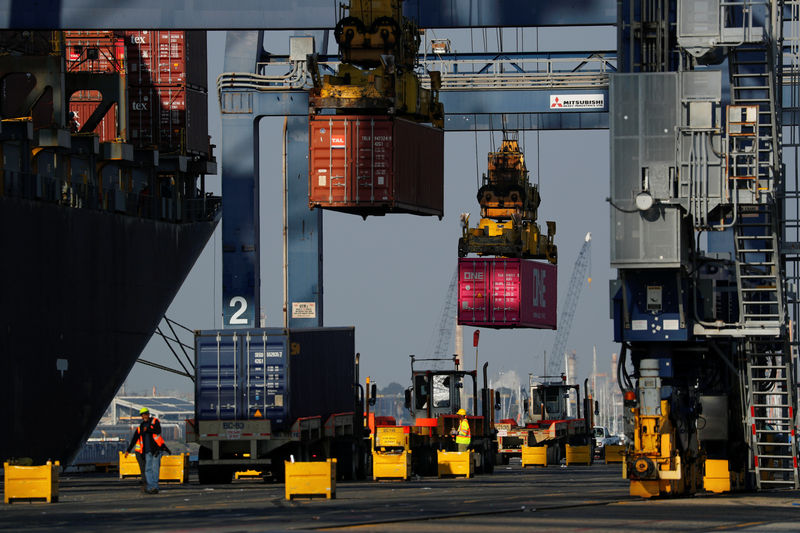By Lucia Mutikani
WASHINGTON (Reuters) - The U.S. trade deficit dropped to its lowest level in nearly 1-1/2 years in October, suggesting trade could contribute to economic growth in the fourth quarter, though a fall in imports of consumer goods hinted at a slowdown in domestic demand.
Still, consumer spending is likely to remain supported by a strong labor market. Other data on Thursday showed the number of Americans filing claims for unemployment benefits unexpectedly dropped last week, hitting their lowest level in seven months.
The reports countered data this week showing manufacturing activity contracting for a fourth straight month in November, a slowdown in growth in the services sector as well as a decline in construction spending in October. The latest data suggested the economy was growing at a moderate pace rather than stall speed.
The Commerce Department said the trade deficit tumbled 7.6% to $47.2 billion, the smallest since May 2018, as both imports and exports of goods declined. It was the second straight monthly fall in the trade bill and the percent drop was the biggest since January.
But the decreases in imports and exports suggested the White House's "America First" agenda, marked by a 17-month trade war with China, was reducing trade flows, which in the long run is detrimental to domestic and global growth.
Data for September was revised to show the trade gap shrinking to $51.1 billion instead of the previously reported $52.5 billion. Economists polled by Reuters had forecast the trade gap narrowing to $48.7 billion in October.
The goods trade deficit with China fell 1.1% to $31.3 billion, with imports unchanged and exports increasing 3.4%.
The goods trade gap with the European Union jumped 20% to $16.4 billion, with imports surging to a record high.
While Washington and Beijing are working on a "phase one" trade deal, the United States has ratcheted up tensions with other trade partners including Brazil, Argentina and France.
President Donald Trump has defended the tariffs as necessary to protect domestic manufacturers from what he says is unfair foreign competition. Trump has accused trading partners, including China, the European Union, Brazil and Argentina of devaluing their currencies at the expense of U.S. manufacturers.
Ironically, the United States has a goods trade surplus with Brazil, which swelled in October to its highest level since March 2014. It is also running a goods trade surplus with Argentina. The goods trade surplus with South and Central America hit a record high in October.
U.S. financial markets were little moved by the data.
STRONG LABOR MARKET
Trade tensions have undermined business investment, which together with slowing growth overseas have led to a recession in manufacturing. That is casting a shadow on the longest economic expansion in history, now in its 11th year.
There are, however, no signs the trade war is significantly impacting the labor market. In a separate report on Thursday, the Labor Department said initial claims for state unemployment benefits dropped 10,000 to a seasonally adjusted 203,000 for the week ended Nov. 30, the lowest level since mid-April.
The claims data has no bearing on November's employment report, which is scheduled for release on Friday. According to a Reuters survey of economists, nonfarm payrolls probably increased by 180,000 jobs in November, boosted by the return of about 46,000 striking General Motors (N:GM) workers. The strike had helped to hold job growth down to 128,000 in October.
Employment gains have slowed this year, averaging 167,000 per month compared with an average monthly gain of 223,000 in 2018, because of ebbing demand and a shortage of workers.
But the pace of hiring has been more than the roughly 100,000 jobs needed per month to keep up with growth in the working-age population. The unemployment rate is forecast holding at 3.6% in November.
When adjusted for inflation, the goods trade deficit decreased $3.9 billion to $79.1 billion in October, also the smallest gap since May 2018.
The drop in the so-called real trade deficit is positive for the calculation of gross domestic product. It suggested trade could add to GDP growth in the fourth quarter after being a drag for two straight quarters. Growth estimates for the fourth quarter are between a 1.3% and 1.9% annualized rate. The economy grew at a 2.1% pace in the third quarter.
But the drivers of the decline in the trade gap in October point to softening economic fundamentals. In October, goods imports dropped 2.1% to $204.1 billion. Consumer goods imports fell $2.4 billion amid declines in cellphones and other household items, toys, games and sporting goods, as well as pharmaceutical preparations. This implies a slower pace of consumer spending after two straight quarters of brisk growth.
Motor vehicle and parts imports dropped $1.8 billion. Motor vehicle parts imports accounted for most of the drop, likely reflecting the GM strike, which undercut motor vehicle production.

Goods exports fell 0.6% to $136.1 billion in October. They were led by a $0.7 billion drop in shipments of consumer goods. Motor vehicle exports and parts exports fell $0.3 billion. There were, however, increases in oil exports, with the petroleum surplus the highest on record.